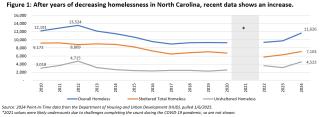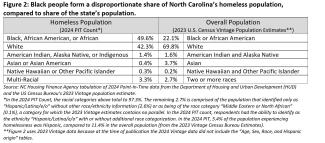
Each year, housing, shelter and social service organizations nationwide conduct a count of people experiencing homelessness on a single night in January (called a “Point-In-Time” count, or PIT), in an attempt to get a complete and unduplicated count of the number of people that are currently unhoused. The 2024 PIT Count found that 11,626 individuals were experiencing homelessness across North Carolina[i]. This is an increase of 19% over the 2023 PIT figures for the state. The nation overall saw a similarly sizable increase in PIT counts: 18% more people experiencing homelessness were counted in 2024 than 2023[ii].
From 2010 to 2024 North Carolina’s population increased by approximately 16% and the nation’s population increased by 10%[iii]. North Carolina’s homeless population decreased by 5% over that time period, while the nation’s increased by 21%[iv]. While homelessness in the state has decreased overall since 2010, an upward trend in the overall homeless population has been evident at least since 2022[v] as shown in Figure 1 below.
Over the last 15 years, North Carolina has outstripped national trends in its increase of unsheltered people. The total population that is homeless and without shelter in the state increased by 50% from 2010 to 2024, compared to 17% nationally[vi]. “Sheltered” homelessness means staying in emergency shelters, transitional housing programs, or safe havens. “Unsheltered” homelessness means the person’s regular nighttime location is not designated for, or ordinarily used, as a regular sleeping accommodation (e.g., a park, bus or train station, abandoned building, car or camping ground).

There is no singular explanation for why the number of individuals experiencing homelessness—sheltered and unsheltered—has increased in recent years. According to the 2024 edition of the Department of Housing and Urban Development’s Annual Homelessness Assessment Report to Congress, North Carolina Continuums of Care (CoCs) attribute this increase to widespread housing unaffordability and increased use of coordinated entry, which enhanced the state’s ability to identify and count those experiencing homelessness. Other stakeholders note that rising inflation, stagnating wages, and the end of COVID-era eviction moratoriums and other housing support programs like rapid rehousing and the Emergency Rental Assistance Program likely played a role[vii].
While the root causes of homelessness are variable and complex, a sizable 2023 study with representative sampling in California concluded that the state’s chronic shortage of housing and high housing costs are at the center of the state’s homelessness crisis. The study found that the population experiencing homelessness does have income (the median monthly household income was $960, over the six months prior to homelessness), but insufficient income to afford housing. Housing cost was the primary barrier to returning to housing.
The PIT count contains some basic demographic information on age, family composition, gender, race and ethnicity, which can reveal important trends about the populations experiencing homelessness in the state. For example, of people who experienced homelessness in North Carolina in 2024[viii]:
- 39% were unsheltered (up from 35% in 2023) and 61% were sheltered (down from 65% in 2023). Of those who were sheltered, approximately 80% of those were in emergency shelters and 20% in transitional housing.
- 28% of those experiencing homelessness are part of families with children, while the remaining 72% are individuals. More than 2,000 children were considered homeless on the night of the PIT count.
- Approximately 22% of the homeless population is 55 years old or older.
- 58% of individuals experiencing homelessness identified as “man”, 41% as “woman” and 0.7% identified themselves as being in the gender categories of “transgender”, “gender questioning”, “culturally specific identity”, “different identity”, “nonbinary”, or “more than one gender”.
- 18% of people experiencing homelessness are chronically homeless (e.g., when a person has been homeless continually for one or more years, or has experienced at least four episodes of homelessness in the last three years and the combined length of time they were homeless is at least 12 months).
- 6% of individuals experiencing homelessness—or 688 people—are veterans, a reduction of 11% (-89 people) from 2023.
- Half of the population experiencing homelessness is Black or African American. Figure 2 below shows that Black individuals experience homelessness disproportionately to their share of the population overall (50% vs. 22%, respectively)[ix].

Hurricane Helene Impacts
The January 2024 PIT count (prior to the arrival of Hurricane Helene) showed 6,620* people experiencing homelessness in the 39 Helene disaster-declared counties[x]. The arrival of Hurricane Helene brought a new and painful dynamic to the homelessness situation in North Carolina. Owner-occupied homes were destroyed or rendered inhabitable, as were many renter-occupied single-family homes and apartment buildings. Households who had been stably housed prior to Helene were suddenly thrust into homelessness and those already experiencing homelessness were made even more vulnerable. In the immediate response to Helene, 22 shelters were opened in western North Carolina for people displaced by the storm[xi]. According to a report by the state’s Office of State Budget and Management, more than 60,000 displaced North Carolinians are expected to be served by shelters as part of Helene response and recovery.
The North Carolina Housing Finance Agency helps address homelessness by financing the development of affordable apartments and partnering with NC Department of Health and Human Services to administer rental assistance. This enables people experiencing homelessness (and other vulnerable populations) to live in the community. To learn more about the Agency’s programs, visit https://www.nchfa.com.
*This blog was updated August 25, 2025. The number of individuals experiencing homelessness in the 39 Helene counties was corrected from 4,812 to 6,620 people.
-------------
[i] 2024 Point-In-Time data from the Department of Housing and Urban Development (HUD), available here. Pulled 1/6/2025.
[ii] NC Housing Finance Agency tabulation of Point-In-Time data from 2023 and 2024. Original data from HUD available here.
[iii] NC Housing Finance Agency tabulation based on the US Census Bureau’s 2010 and 2020 Decennial surveys and the US Census Bureau’s 2024 Vintage population estimate. Available here and here.
[iv] NC Housing Finance Agency tabulation of 2010 and 2024 Point-In-Time data from HUD, available here. Pulled 1/6/2025.
[v] The 2021 PIT Count included sheltered people experiencing homelessness, but counts of unsheltered people were not as exhaustive as in prior or subsequent counts.
[vi] NC Housing Finance Agency tabulation of 2010 and 2024 Point-In-Time data from HUD, available here. Pulled 1/6/2025.
[vii] 2024 Annual Homelessness Assessment Report to Congress, by HUD, available here.
[viii] NC Housing Finance Agency tabulation of Point-In-Time data from HUD, available here. Pulled 1/6/2025.
[ix] NC Housing Finance Agency tabulation of 2024 Point-In-Time data from HUD, available here (pulled 1/6/2025) and the US Census Bureau’s 2023 Vintage population estimate, available here.
[x] NC Housing Finance Agency tabulation of 2024 Point-In-Time data from HUD, available here (pulled 1/6/2025) and Balance of State Continuum of Care data by county from 2024, pulled 1/6/2024 from the website of the North Carolina Coalition to End Homelessness (www.ncceh.org).
[xi] OSBM report “Hurricane Helene Recovery Recommendations: Preliminary Damage and Needs Assessment” published October 23, 2024. Since the peak shelter activity most of the 22 shelters have been able to close (as of the time of this blog).